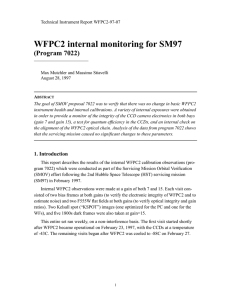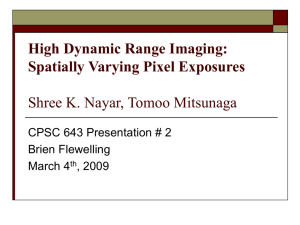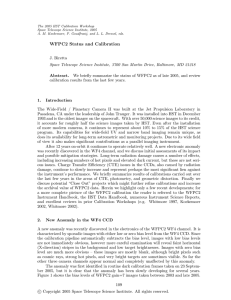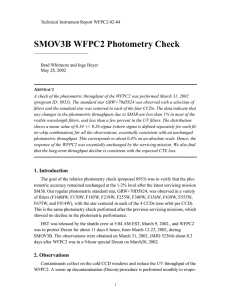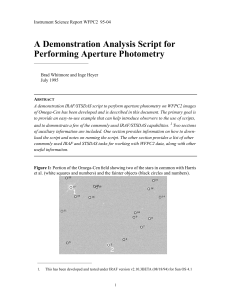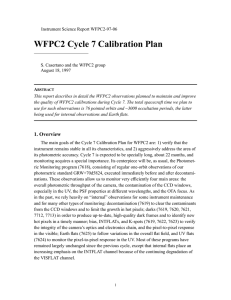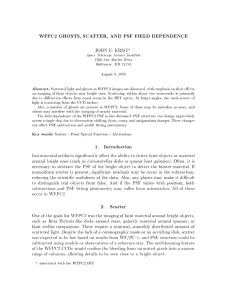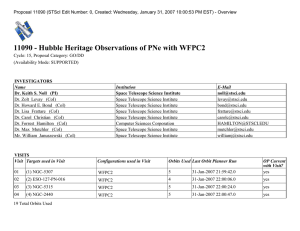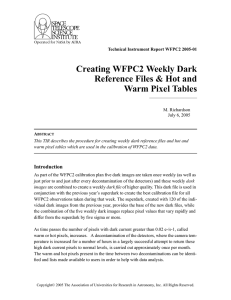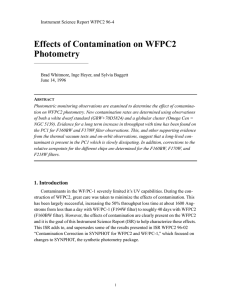WFPC2 Electronics Verification
advertisement
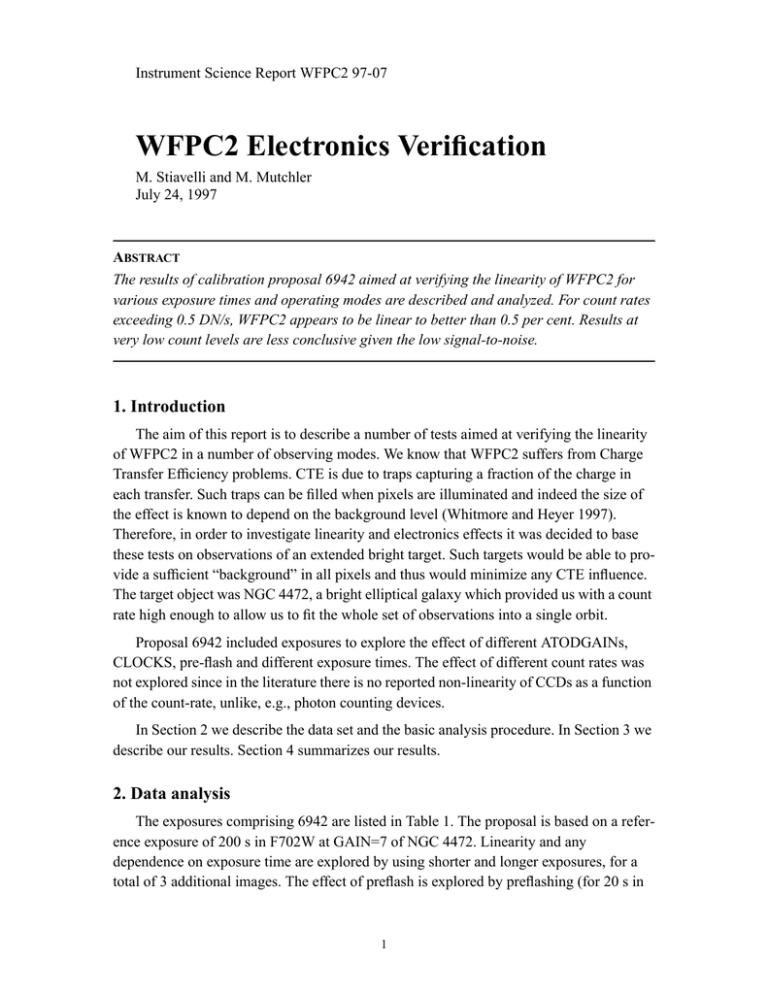
Instrument Science Report WFPC2 97-07 WFPC2 Electronics Verification M. Stiavelli and M. Mutchler July 24, 1997 ABSTRACT The results of calibration proposal 6942 aimed at verifying the linearity of WFPC2 for various exposure times and operating modes are described and analyzed. For count rates exceeding 0.5 DN/s, WFPC2 appears to be linear to better than 0.5 per cent. Results at very low count levels are less conclusive given the low signal-to-noise. 1. Introduction The aim of this report is to describe a number of tests aimed at verifying the linearity of WFPC2 in a number of observing modes. We know that WFPC2 suffers from Charge Transfer Efficiency problems. CTE is due to traps capturing a fraction of the charge in each transfer. Such traps can be filled when pixels are illuminated and indeed the size of the effect is known to depend on the background level (Whitmore and Heyer 1997). Therefore, in order to investigate linearity and electronics effects it was decided to base these tests on observations of an extended bright target. Such targets would be able to provide a sufficient “background” in all pixels and thus would minimize any CTE influence. The target object was NGC 4472, a bright elliptical galaxy which provided us with a count rate high enough to allow us to fit the whole set of observations into a single orbit. Proposal 6942 included exposures to explore the effect of different ATODGAINs, CLOCKS, pre-flash and different exposure times. The effect of different count rates was not explored since in the literature there is no reported non-linearity of CCDs as a function of the count-rate, unlike, e.g., photon counting devices. In Section 2 we describe the data set and the basic analysis procedure. In Section 3 we describe our results. Section 4 summarizes our results. 2. Data analysis The exposures comprising 6942 are listed in Table 1. The proposal is based on a reference exposure of 200 s in F702W at GAIN=7 of NGC 4472. Linearity and any dependence on exposure time are explored by using shorter and longer exposures, for a total of 3 additional images. The effect of preflash is explored by preflashing (for 20 s in 1 F502N) a single 200 s NGC 4472 image. Similarly we test CLOCKS=YES and GAIN=15 with single 200 s exposures. Although the center of NGC 4472, placed in WF3, never saturates, the highest count levels are tested thanks to a bright, saturated star in WF3. For each exposure we first checked that the pointing had not shifted, then for the PC and each of the WF chips we converted the calibrated two-dimensional images into one dimensional vectors (IRAF imtab command). These vectors were then merged together into a single vector. The analysis is based upon the pixel to pixel comparison of pairs of these vectors. Whenever the ratio of the two values in a pair differs by more than the estimated scatter based on the count rate and the read-out noise, the pair is clipped and removed from the following analysis. Cosmic rays and hot pixels are thus ignored. Areas of 49 pixels around the pyramid edges are also discarded. The number of useful pixels in each exposure pair is typically reduced to about 1.5 M pixels. We have checked that even shifting the pointing (artificially) by one in both the X and Y directions does not affect our results except at the highest count rates (occurring in stars and in the galaxy core). Table 1. Observing log for proposal 6942. The target is always NGC 4472 and the filter is always F702W. Exposure time (s) Gain Pre-flash Clocks 200 7 yes no 200 7 no no 100 7 no no 50 7 no no 200 15 no no 200 7 no yes 350 7 no no Since the galaxy light distribution varies across the chips, by carrying out a pixel by pixel comparison one can easily explore any effect in a simple and sensitive way. For most applications the pixel values were binned depending on their count rate in order to study fractional frame to frame differences. The analysis of the pre-flashed image was different since the pre-flash pattern had to be subtracted. This was done by obtaining first an highsignal to noise pre-flash pattern by combining 6 images from the archive. The pattern was normalized according to exposure time and subtracted from the preflashed image. The subtraction error based on experimenting with different scaling was smaller than 0.3 DN. The error bars are standard deviations on the mean value computed for any given count rate. We should also note that bias jumps are present on some of the frames at a rather low level. Such jumps will typically affect our results to about 1.5 electrons. 2 3. Results Linearity was verified by studying three pairs of exposures: the 350 s vs 50 s pair was studied in order to have the largest exposure time difference. In Figure 1 it is plotted together with the 200 s vs 50 s pair and the 350 s vs 100 s pair. The advantage of these pairs is that they represent comparable exposure time ratios and are statistically independent from one another. Apart from the lowest bin in count rate, corresponding to count rates lower than 3 electrons/s, any deviation is smaller than 0.5 per cent. The small wavy pattern visible in the figure could be real since it is seen in all three pairs, two of which are entirely independent. If true it would imply linearity departures at the level of 0.3 per cent. Figure 1: Effect of varying exposure times on the measured counts. Open squares correspond to 350s vs 50s data, filled triangles to 200s vs 50s data, and 5 pointed stars to 350s vs 100s data. The reason why there is a deviation at low count rates is not clear. In order to better investigate this effect we have focused on count rates lower than 1.5 e/s (see Figure 2). 3 Figure 2: Effect of varying exposure times on the measured counts for low count rates. Symbols are identical to Figure 1. The curves represent the effect of losing, due to traps, 1, 3, 5, or 10 electrons per pixel. As shown by the curves in Figure 2, the loss of a fixed number of electrons in each pixel (which seems to describe accurately the so-called “short-vs-long” effect, http:// www.stsci.edu/ ftp/ instrument_news/ WFPC2/ Wfpc2_cte/ ctetop.html) is not able to explain the observed effect. Note that a varying sky background would be equivalent to a fixed background. In a similar way, it is hard to imagine how CTE could produce the observed behaviour, and, in particular, the relative increase in flux of short exposures for count rates of about 0.3 electrons/s. In order to strengthen this conclusion we have looked for a Y (or an X) dependence of the (short-long) residuals and found none within our errors. A more complete investigation of this issue would require two CR-split version of 4 the 50 s and the 350 s exposure with different pointings, so as to better disentangle effects dependent on the position on the chip from those dependent on the counts per pixel. The CLOCKS=YES data (see also Figure 3) do not shown any trend with count rate, but it appears to be shifted by about 0.3 per cent. Since the exposure was taken with the B shutter its length is shorter by 0.25 seconds (see WFPC2 Handbook Section 2.6), for the adopted exposure time of 200 seconds this is equivalent to a 0.125 per cent effect and thus it cannot explain (alone) the observed shift. The possibility remains that some additional (so far unknown) effect shortens exposures with serial clocks on. Figure 3: Effect of CLOCKS=YES. The point at count rate ~130 electrons/s corresponds to pixels in the saturated star in WF3. We have a single image with GAIN=15. The data do not allow us to rederive or check the IDT derived gain ratios since the count rates are relatively low for most of the image. Internal flats as discussed in the WFPC2 ISR 96-01 are a much better way to check the gain ratios. The analysis of our frames yields gain ratios consistent with 2.0 within the errors. Correcting the data with the IDT gain ratios produces an overall shift and eliminates an offset which would otherwise be present (see Figure 4) but does not reduce 5 significantly the scatter. When we analyze the differences in counts as a function of count rates we find that the GAIN=15 data show some structure at the 0.5 per cent level or less. Apart from the innermost points which seems to be always discrepant all remaining points show an effect smaller than 0.3 per cent (see Figure 4). It is not clear to us what is the reason for the discrepancy of the first point, apart from the fact that clearly the low count rates are those with the largest errors. Figure 4: Effect of GAIN setting. We plot the relative difference between GAIN=7 and GAIN=15. The squares correspond to a nominal gain ratio of 2, while the filled triangles are for the IDT chip-dependent gain ratios. The pre-flashed data (Figure 5) how clearly the presence of a trend which could be interpreted as a uniform shift by 13 electrons in the counts of each pixel. One possible, and perhaps the most likely, interpretation is that the sky background was higher in the preflashed exposure due, e.g., to the fact that this exposure is the first of the series and could have been influenced by the bright earth. 6 Regardless of the interpreation of this shift, however, the corrected data, shifted back by 13 electrons, do not show any trend. Given that any CTE effect would argueably show a dependence similar to the pre-flash pattern, we tentatively exclude the hypothesis that the shift is originated by traps. In Figure 5 we show both the corrected and the uncorrected points as well as the corrected points excluding WF2 which is affected by a 0.5 DN bias jump. Figure 5: Effect of pre-flash. The open squares correspond to the uncorrected preflashed frame, the filled triangles have been corrected by removing 13 electrons from each pixel in the preflashed image. Open hexagons corresponds to the corrected data excluding WF2, which is affected by a large bias jump. 4. Discussion These data suggest that WFPC2 does not suffer from any linearity effect at the higher count rates. For count rates of 2-3 electrons per second and lower, these data give a less 7 clear answer. Formally we detect an effect at about the one per cent level. However, our formal error bars are valid under the assumption that all points are uncorrelated and ignore any systematic effect. The former is almost certainly incorrect since nearby pixels are correlated via the pixel-response-function and, possibly, by transfer inefficiencies. It has been argued (WFP2 Web page http://www.stsci.edu/ ftp/ instrument_news/ WFPC2/ Wfpc2_cte/ctetop.html) that the addition of 2-3 electrons to WFPC2 pixels with low counts would correct for the effect of traps in the so-called “short-vs-long” effect.. We find instead that in this specific case this addition would not cure the problem at low count rates. Finally, as expected for uniform sources, we have no evidence for an Y (or an X) dependence in the data, suggesting that the standard CTE is probably not affecting these data. The analysis of 6942 data has also given us indication of how it would be possible to further the investigation with a more extensive data set. In particular one might consider: • short (50 s) and long (350 s) exposures with CR-SPLIT in order to improve the signal at low count rates by allowing for a better CR subtraction. • a standard 200 s exposure with, e.g., F673N in order to explore, at roughly the same wavelength, the effect of different count rates. • a standard 200 s exposure with, e.g., F450W in order to investigate the presence of wavelength dependent effects. Clearly all these exposures should again be repeated within the same visit since a difference in pointing could seriously complicate the data analysis or even make it infeasible. 5. Acknowledgements We thank Brad Whitmore for extensive comments on an early draft of this document. 8

